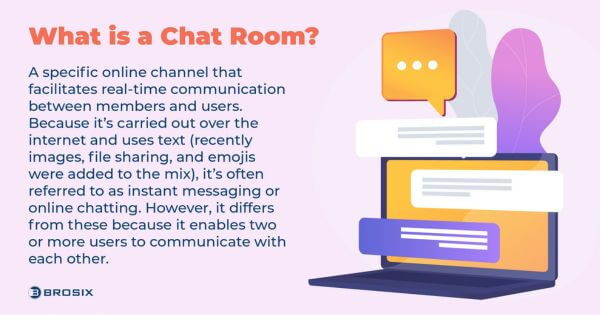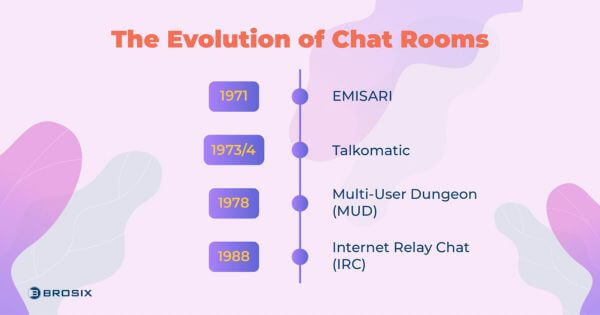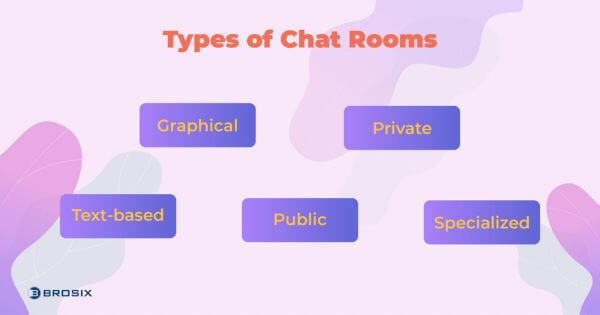Ever wondered what a chat room is and how it works?
This article is for you, then.
In the post below, we cover the chat room definition and how its evolution led to the different types available on the market today. You’ll also discover key pros and cons and innovative use cases.
Stick around to get all your questions answered.
Chat Rooms (Key Takeaways)
- Chat rooms are online platforms that facilitate real-time communication among multiple users, allowing for both synchronous and asynchronous interactions.
- The concept of chat rooms dates back to the early 1970s. Key milestones include Talkomatic, CompuServe’s CB Simulator, Multi-User Dungeon (MUD), and Internet Relay Chat (IRC).
- Chat rooms can be text-based or graphical, public or private, and serve specialized purposes. They adapt to various contexts, fostering communication in both casual and formal settings.
- Chat rooms offer real-time, flexible communication and can boost team collaboration and productivity. However, they also pose certain challenges.
- In business, chat rooms are valuable for facilitating secure, collaborative workspaces, and are used in educational and customer service settings.
What Is a Chat Room?

A chat room is a specific online channel that facilitates real-time communication between members and users. Because it’s carried out over the internet and uses text (recently images, file sharing, and emojis were added to the mix), it’s often referred to as instant messaging or online chatting. However, it differs from these because it enables two or more users to communicate with each other.
It can also be synchronous or asynchronous communication and may be divided into private and public categories. For example, if you’re curious about what a private chat room is, this is a dedicated space where only members with the right credentials can enter and access to communicate with similar members based on user roles and unique login details for added safety and enhanced privacy.
Overall, the main purpose of chat rooms is to communicate and share information. This can be both private and public, as well as formal and informal. For example, communication in chat rooms can take place between friends, coworkers, strangers, etc.
Since it is internet-based, it is often fast and instantaneous, allowing for quick and streamlined discussions and collaboration, irrespective of where members or users are based geographically.
As for the question, “What is the main feature of chat rooms?” the answer is that as a communication platform, it looks like a text box where chats take place. This chat box is usually visible to all participants or only those who have permission to be in the chat room.
In short, chat rooms are becoming more prevalent in the online space and play a key role in fostering more streamlined digital communication.
The Evolution of Chat Rooms

Having explored the answer to the question “What are chat rooms?” let’s shift gears and rewind the clock back to the early 1970s. For those among you who want to know when chat rooms were invented, we’ve got the details below.
Early beginnings
To answer when chat rooms started, we need to look at related solutions that gave us the modern version we know today.
In 1971, Murray Turoff developed the first chat system, called EMISARI, which was used by the US government. Through it, 10 regional offices could link with one another in real time to communicate. Known as the “party line,” it was used all the way until 1986.
Talkomatic, Multi-User Dungeons (MUD), and Internet Relay Chat (IRC)
Next up came the first public online chat or online conferencing system called Talkomatic. It was created in 1973/4 and was developed by Doug Brown and David R. Woolley in the US. Up to five people could communicate with each other in different channels, again in real time. Users could see each character as it was being typed on the screen. The founders released a web-based version in 2014.
Across the pond in the UK, in 1978 British computer programmer Roy Trubshaw created a chat room called Multi-User Dungeon (MUD). Inspired by the Dungeons & Dragons video game, the MUD was initially meant for him and his friends. But the concept spread, and by mid-1990, more than 400 MUD chat rooms were created. They were initially made for gaming but later evolved.
In 1980, the CompuServe CB Simulator was released to the public. This was the first online chatting system available for widespread use. It was created by Alexander Trevor in the US.
And in between all this, when 1988 rolled around, Jarkko Oikarinen created Internet Relay Chat (IRC). It was initially only comprised of a single network and server. The main aim was to encourage communication between people with similar interests. In just one year, this early chat room provider spread to 40 global servers, and in 1991, it became a channel for information about political events such as the Persian Gulf War. In the 2020s, there were over 400 split-off networks from the original IRC.
Development of graphical multi-user environments
Taking things up a notch, chat rooms later developed into graphical multi-user environments. This means using virtual reality technology to add two- or three-dimensional graphics to the chat experience. An example of this could be a member using an avatar.
Types of Chat Rooms

Chat rooms can be one-on-one or group-based. However, they can also be text- and graphic-based, public and private, as well as specialized.
Let’s explore these options in more detail below.
- Text-based chat rooms: Most chat rooms are text-based, which means that users type in text in a text box, which is relayed to the received. Recently, these texts have been accompanied by the inclusion of emoticons and even file-sharing options.
- Graphical chat rooms: Graphical chat rooms are based on text along with graphics. As mentioned earlier, these graphics can include user avatars for greater anonymity or more accurate representations of their role in the chat room.
- Public chat rooms: Public chat rooms are available to the public at large. For instance, they can include communities of gamers where strategies are discussed.
- Private chat rooms: Private chat rooms are, as the name suggests, private and accessible only to designated users. These are often used in professional settings between teams and coworkers.
- Specialized chat rooms: While the most obvious purposes of chat rooms are for gaming and professional reasons, there are other specialized chat rooms that fulfill important functions. These include support groups, book clubs, language exchanges, parenting groups, hobbyist communities, cultural or ethnic communities, activism and advocacy groups, health and fitness rooms, movie or TV show fan clubs, as well as creative writing and art groups.
Advantages and Disadvantages of Chat Rooms
With so many purposes and ways to use chat rooms, their advantages are numerous. However, as with every online space, there are some disadvantages of chat rooms to consider as well.
Here’s a balanced exploration of both the pros and cons worth keeping in mind.
| Benefits | Challenges |
| Real-time communication with no lags or delays | Potential security breaches and information interception |
| Anonymity of users, depending on the type of chat room | Possible miscommunication and potential for abuse due to misinterpretations of the business communication words and phrases |
| Selecting the right chat room functions offers greater levels of control | Impulses to overshare, which can be used against you in the future |
| Improves flexibility and focus of teams that can act as a helpful brainstorming tool | Letting the wrong people into your network |
| Helps to keep remote teams engaged, feeling a part of the team or project | Requires employee training tools for proper usage |
| Chat rooms can help improve team collaboration and communication | Disruptive users may need to be reported to a team leader |
| Great resources can help facilitate optimal productivity, improve work performance, and bolster mutual respect | Poor online communication etiquette, which can result in online bullying, as demonstrated by recent cyberbullying statistics |
| They can be safe spaces that connect people through strong encryption |
Innovative Uses of Chat Rooms
Chat rooms come in handy in a variety of scenarios, especially in the business world, where ensuring safe and secure professional group communication is key.
Some examples of innovative use cases of group chats and chat rooms are in professional and collaborative workspaces. With an assigned network administrator at your organization, your team can take advantage of chat room controls. This means that chat rooms can be opened or closed when you need them. Also, you can add relevant team members to chat rooms as well.
For example, you can create temporary chat rooms for tech projects, for your finance team at the end of each financial year, or even for your human resources (HR) team, which can use specialized chat rooms during a cyclical hiring season.
Other key use cases include educational settings for remote learning or support platforms for customer service.
Example of Chat Room Software: Brosix
When it comes to secure business and team instant messaging and chat rooms, Brosix paves the way for secure and safe online communication through peer-to-peer encryption.
Through our chat room controls, you can facilitate focused and flexible team communication, whether you work in an office or you work with remote teams. Some of our software’s unique features and capabilities include:
- Create or shut down a chat room
- Controlling who is allowed to leave or join a chat room
- The Room Lock option allows you to predefine the user composition of your chat room
- The Open Room option allows you to let users add other users to the room
- With the Screenshot function, you can easily send screenshots to your group
- The Virtual Whiteboard facilitates smoother team collaboration and brainstorming or problem-solving
- With a chat room for groups, you can keep employees engaged as they’re allowed to enter or leave at will while enabling them to connect with each other
All this happens through the Brosix Web Control Panel and in a few simple clicks. With a dedicated communication space, you can now enjoy greater team collaboration and heightened productivity.
And if you still aren’t convinced, here’s a brief mention of the reliable and convenient Brosix chat group functionality a user shared:
“We set up groups which is great on our end, depending on who we need to communicate with all at one time. [We] can also share screens to help in more detail or send documents within the Brosix messenger.” — Brandy W.
Conclusion
Chat rooms have evolved from traditional ways to communicate to sophisticated and highly secure systems that enable professional and business teams to collaborate in real time.
Introducing greater team productivity and efficiency, the future of chat rooms remains bright as a growing number of businesses rely on them for streamlined communication due to dispersed and remote teams.






